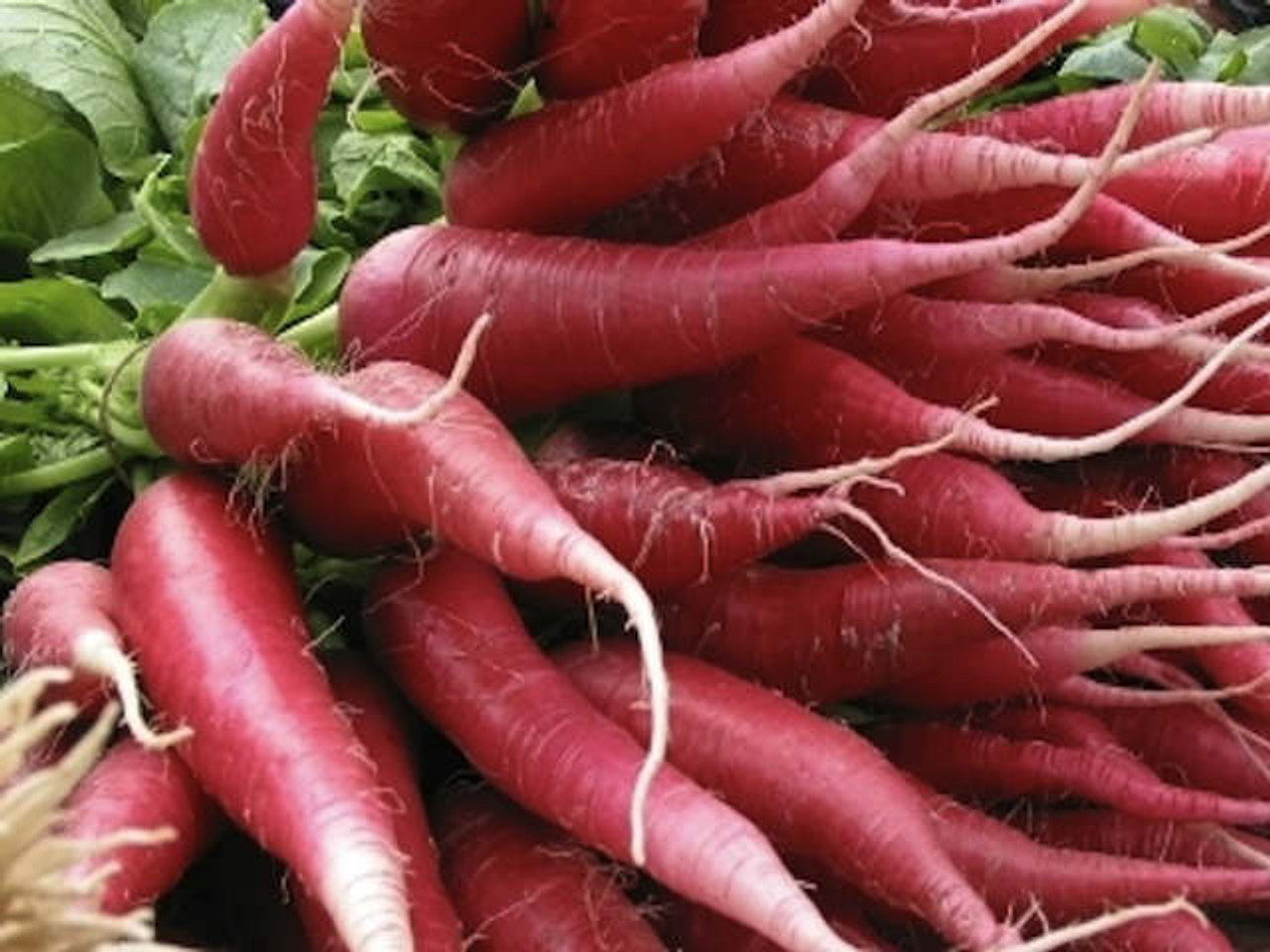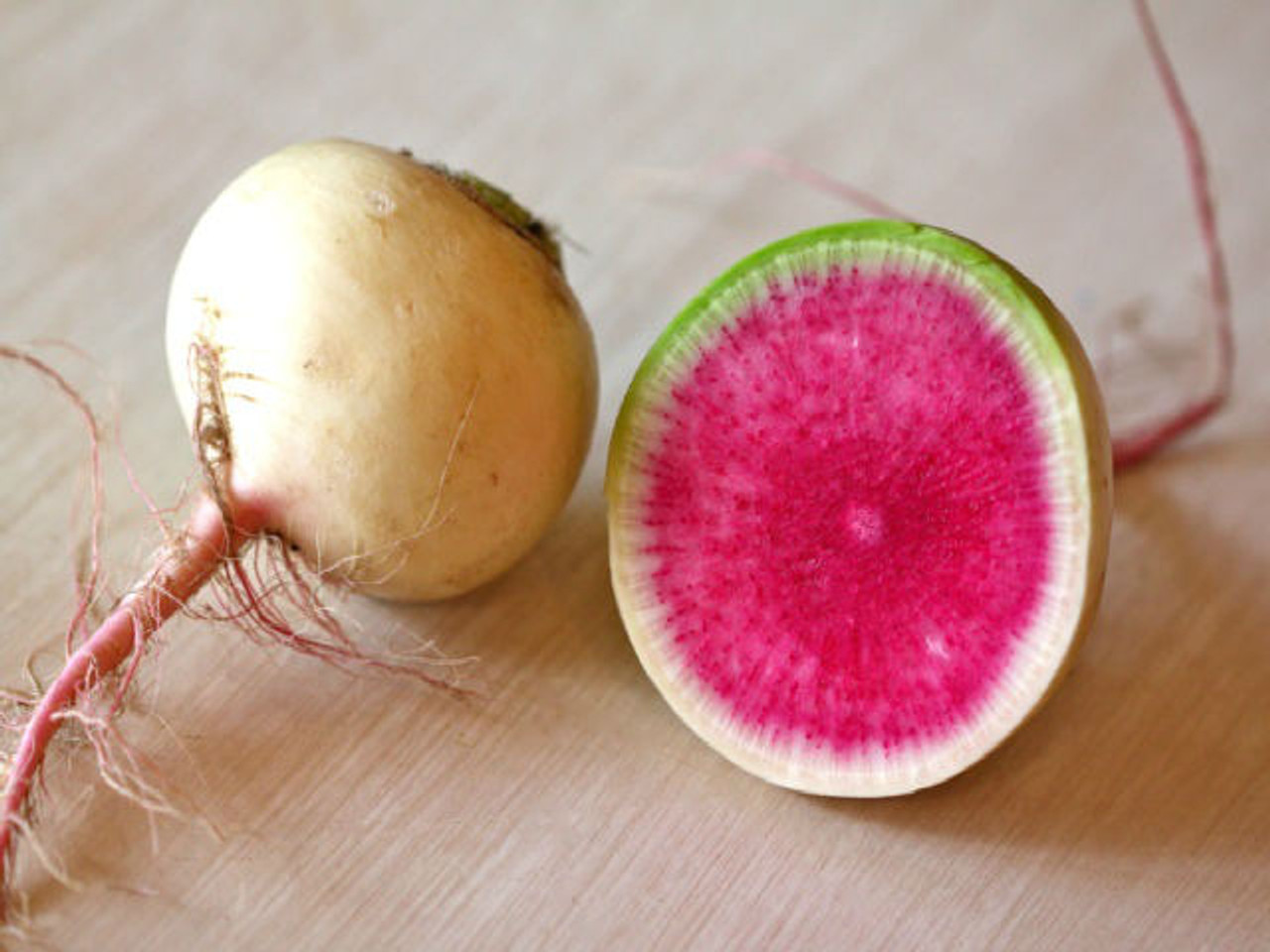A Guide to Radish Types

While it is most commonly visualised as a bright red vegetable, there is a delightful amount of variety when it comes to growing your own radish. For simplicity's sake the vegetable can be divided into 4 main types. Here's the gist of it:
Summer or Table Radishes
These are usually small-rooted and red, pink or white in colour. They include varieties like 'Short Top Forcing', Cherry Bell and French Breakfast. Flavour-wise they are generally hot and peppery.

Summer radishes are ready from about 4 weeks after sowing, after which time they will either become woody or run to seed. They are hardy, so can be sown from late March/early April until late July.
Storage or Winter Hardy Radish
Radishes for storage tend to be larger than table radishes (about 2-4 inches in diameter) and with a coarser flesh. They are excellent in stews. They can be left in the ground over winter (if the ground isn't too wet) or stored in boxes of moist sand.

'China Rose' Radish
View ProductWhen left in the ground, winter radishes can produce delicious, succulent and spicy seed pods the following year. Varieties include 'Black Spanish' and 'China Rose'.
Asian Radish
Asian radishes include the long white 'Mooli' or 'Daikon' varieties and the pretty and sweet 'Beauty Heart' or 'Watermelon' radish. In general Asian varieties are difficult to grow earlier in the year, as they are prone to bolting - but are ideal as Autumn or overwintering crops.

Asian radishes range from mild to hot and and are equally good when cooked as they are raw. Finely chopped 'Mooli' varieties are typically used as a garnish around sushi, or grated and sprinkled with salt and lemon juice as a refreshing salad.
Seed Pod Radish
Radishes have also been specially bred to produce larger seed pods than standard winter varieties, so if you like the tasty pods it may be worth giving these a try.

Radishes produced for their pods are generally known as 'Rats Tail Radishes'. That may not the most attractive name, but they are delicious added to stir fries or salads, where they add a welcome peppery bite.
Rats tail radishes can also be pickled, and taste wonderful on their own or as a side dish to grilled meat or fish where you might normally use capers.

Watermelon Radish
View ProductSome Radish Serving Ideas:
Summer Radishes with salt, butter and anchovies
I can understand why many of you mightn't like salted anchovies - they're not for everyone. If you don't fancy their strong flavour just leave them out; the radishes are still delicious without.
Ingredients:
1 Summer Radishes
2 Tbs butter
1 tsp tinned anchovies
1 pinch sea salt

Wash the radishes and slice in half. Mix the butter and anchovies to form a paste, and smear a dollop on each half radish. Sprinkle the sea salt at the last minute before you eat, so the salt remains crunchy and doesn't have time to dissolve.
Roasted Radishes
I'm a big fan of roasted vegetables in general (particularly beetroot), so the idea of roasting radishes makes perfect sense to me. Cooking radishes takes away their strong bite and brings out their mellow sweetness. These quick and easy roasted radishes make a handy snack. Try them with some crusty bread, olives and feta cheese.

Toss halved and trimmed radishes on a baking sheet with olive oil, sea salt, and freshly ground black pepper. Roast at 425° until crisp-tender, about 10 minutes. Toss with fresh lemon juice, room- temperature butter, and chopped fresh herbs; season with flaky sea salt.
Pickled Radish Pods
Ingredients:
250 ml radish pods
50 grams salt
2 dried chilies
280 ml white wine vinegar
Pick the pods on a dry day. Discard any that are blemished or hard.
Make up a brine with salt and 500 ml water, and plunge the pods into it while still hot. If they look bright green they are ready for pickling. If not, strain them off, re-boil the brine and repeat the process.
Strain off the brine and wash the pods under cold water to get rid of excess salt. Drain well and pack into clean, sterilised jars with the dried chillis. Heat up the vinegar and boil for 5 mins, then cool. Pour over the pods, seal and store for a couple of months.


